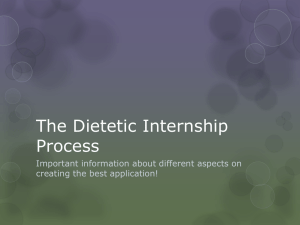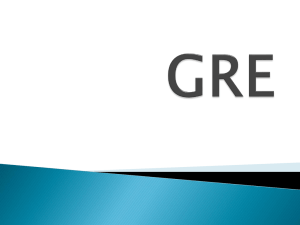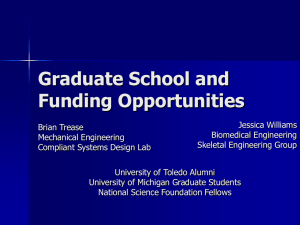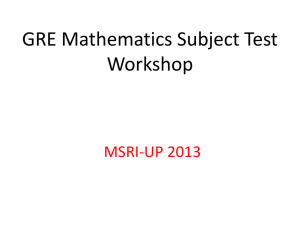Stepwise Regression
advertisement
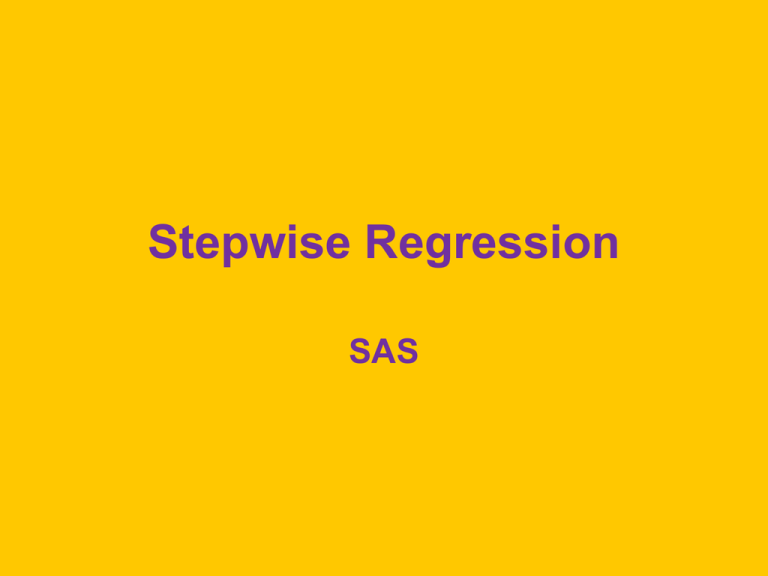
Stepwise Regression SAS Download the Data • http://core.ecu.edu/psyc/wuenschk/StatData/St atData.htm 3.2 625 540 65 2.7 4.1 575 680 75 4.5 3.0 520 480 65 2.5 2.6 545 520 55 3.1 3.7 520 490 75 3.6 4.0 655 535 65 4.3 4.3 630 720 75 4.6 2.7 500 500 75 3.0 and so on Download the SAS Code • http://core.ecu.edu/psyc/wuenschk/SAS/SASPrograms.htm data grades; infile 'C:\Users\Vati\Documents\StatData\MultReg.dat'; input GPA GRE_Q GRE_V MAT AR; PROC REG; a: MODEL GPA = GRE_Q GRE_V MAT AR / STB SCORR2 selection=forward slentry = .05 details; run; Forward Selection, Step 1 Statistics for Entry DF = 1,28 Variable Tolerance GRE_Q GRE_V MAT AR 1.000000 1.000000 1.000000 1.000000 Model R-Square 0.3735 0.3381 0.3651 0.3853 F Value Pr > F 16.69 14.30 16.10 17.55 0.0003 0.0008 0.0004 0.0003 All predictors have p < the slentry value of .05. AR has the lowest p. AR enters first. Step 2 Statistics for Entry DF = 1,27 Variable Tolerance GRE_Q GRE_V MAT 0.742099 0.835714 0.724599 Model R-Square 0.5033 0.5155 0.4923 F Value Pr > F 6.41 7.26 5.69 0.0174 0.0120 0.0243 All predictors have p < the slentry value of .05. GRE-V has the lowest p. GRE-V enters second. Step 3 Statistics for Entry DF = 1,26 Variable Tolerance GRE_Q MAT 0.659821 0.670304 Model R-Square 0.5716 0.5719 F Value Pr > F 3.41 3.42 0.0764 0.0756 No predictor has p < .05, forward selection terminates. The Final Model Parameter Estimates Variable DF Parameter Estimate Standard t Value Error Pr > |t| Standard Squared ized SemiEstimate partial Corr Type II Intercept 1 0.49718 0.57652 0.86 0.3961 0 GRE_V 1 0.00285 0.00106 2.69 0.0120 0.39470 0.13020 AR 1 0.32963 0.10483 3.14 0.0040 0.46074 0.17740 . R2 = .516, F(2, 27) = 14.36, p < .001 Backward Selection b: MODEL GPA = GRE_Q GRE_V MAT AR / STB SCORR2 selection=backward slstay = .05 details; run; • We start out with a simultaneous multiple regression, including all predictors. • Then we trim that model. Step 1 Variable Parameter Estimate Intercept -1.73811 GRE_Q 0.00400 GRE_V 0.00152 MAT 0.02090 AR 0.14423 Standard Error 0.95074 0.00183 0.00105 0.00955 0.11300 Type II SS F Value Pr > F 0.50153 0.71582 0.31588 0.71861 0.24448 3.34 4.77 2.11 4.79 1.63 0.0795 0.0385 0.1593 0.0382 0.2135 GRE-V and AR have p values that exceed the slstay value of .05. AR has the larger p, it is dropped from the model. Step 2 Statistics for Removal DF = 1,26 Variable Partial R-Square GRE_Q 0.1236 GRE_V 0.0340 MAT 0.1318 Model R-Square 0.4935 0.5830 0.4852 F Value Pr > F 8.39 2.31 8.95 0.0076 0.1405 0.0060 Only GRE_V has p > .05, it is dropped from the model. Step 3 Statistics for Removal DF = 1,27 Variable Partial R-Square GRE_Q 0.2179 MAT 0.2095 Model R-Square 0.3651 0.3735 F Value Pr > F 14.11 13.56 0.0008 0.0010 No predictor has p < .05, backwards elimination halts. The Final Model Parameter Estimates Variable DF Parameter Estimate Standard t Value Error Pr > |t| Standard Squared ized SemiEstimate partial Corr Type II Intercept 1 -2.12938 0.92704 -2.30 0.0296 0 GRE_Q 1 0.00598 0.00159 3.76 0.0008 0.48438 0.21791 MAT 1 0.03081 0.00836 3.68 0.0010 0.47494 0.20950 R2 = .5183, F(2, 27) = 18.87, p < .001 . What the F Test? • Forward selection led to a model with AR and GRE_V • Backward selection led to a model with MAT and GRE_Q. • I am getting suspicious about the utility of procedures like this. Fully Stepwise Selection c: MODEL GPA = GRE_Q GRE_V MAT AR / STB SCORR2 selection=stepwise slentry=.08 slstay = .08 details; run; • Like forward selection, but, once added to the model, a predictor is considered for elimination in subsequent steps. Step 3 • Steps 1 and 2 are identical to those of forward selection, but with slentry set to .08, MAT enters the model. Statistics for Entry DF = 1,26 Variable Tolerance GRE_Q MAT 0.659821 0.670304 Model R-Square 0.5716 0.5719 F Value Pr > F 3.41 3.42 0.0764 0.0756 Step 4 • GRE_Q enters. Now we have every predictor in the model Statistics for Entry DF = 1,25 Variable Tolerance GRE_Q 0.653236 Model R-Square 0.6405 F Value Pr > F 4.77 0.0385 Step 5 • Once GRE_Q is in the model, AR and GRE_V become eligible for removal. Statistics for Removal DF = 1,25 Variable Partial R-Square GRE_Q 0.0686 GRE_V 0.0303 MAT 0.0689 AR 0.0234 Model R-Square 0.5719 0.6102 0.5716 0.6170 F Value Pr > F 4.77 2.11 4.79 1.63 0.0385 0.1593 0.0382 0.2135 Step 6 • AR out, GRE_V still eligible for removal. Statistics for Removal DF = 1,26 Variable Partial R-Square GRE_Q 0.1236 GRE_V 0.0340 MAT 0.1318 Model R-Square 0.4935 0.5830 0.4852 F Value Pr > F 8.39 2.31 8.95 0.0076 0.1405 0.0060 Step 7 • At this point, no variables in the model are eligible for removal • And no variables not in the model are eligible for entry. • The final model includes MAT and GRE_Q • Same as the final model with backwards selection. R-Square Selection • d: MODEL GPA = GRE_Q GRE_V MAT AR / selection=rsquare cp mse; run; • Test all one predictor models, all two predictor models, and so on. • Goal is the get highest R2 with fewer than all predictors. One Predictor Models Number in Model 1 1 1 1 R-Square C(p) MSE 0.3853 0.3735 0.3651 0.3381 16.7442 17.5642 18.1490 20.0268 0.22908 0.23348 0.23661 0.24667 Variables in Model AR GRE_Q MAT GRE_V One Predictor Models • AR yields the highest R2 • C(p) = 16.74, MSE = .229 • Mallow says best model will be that with small C(p) and value of C(p) near that of p (number of parameters in the model). • p here is 2 – one predictor and the intercept • Howell suggests one keep adding predictors until MSE starts increasing. Two Predictor Models Number in R-Square Model 2 0.5830 C(p) MSE 4.9963 0.16116 2 2 2 0.5155 0.5033 0.4935 9.6908 10.5388 11.2215 0.18725 0.19196 0.19575 2 2 0.4923 0.4852 11.3019 11.7943 0.19620 0.19894 Variables in Model GRE_Q MAT GRE_V AR GRE_Q AR GRE_V MAT MAT AR GRE_Q GRE_V Two Predictor Models • Compared to the best one predictor model, that with MAT and GRE_Q has – Considerably higher R2 – Considerably lower C(p) – Value of C(p), 5, close to value of p, 3. – Considerably lower MSE Three Predictor Models Number in R-Square Model 3 0.6170 C(p) MSE 4.6292 0.15369 3 0.6102 5.1050 0.15644 3 0.5719 7.7702 0.17182 3 0.5716 7.7888 0.17193 Variables in Model GRE_Q GRE_V MAT GRE_Q MAT AR GRE_V MAT AR GRE_Q GRE_V AR Three Predictor Models • Adding GRE_V to the best two predictor model (GRE_Q and MAT) – Slightly increases R2 (from .58 to .62) – Reduces [C(p) – p] from 2 to .6 – Reduces MSE from .16 to .15 • None of these stats impress me much, I am inclined to take the GRE_Q, MAT model as being best. Closer Look at MAT, GRE_Q, GRE_V • e: MODEL GPA = GRE_Q GRE_V MAT / ParameterSTB Estimates SCORR2; run; Variable DF Parameter Estimate Standard t Value Error Pr > |t| Standard Squared ized SemiEstimate partial Corr Type II Intercept 1 -2.14877 0.90541 -2.37 0.0253 0 GRE_Q 1 0.00493 0.00170 2.90 0.0076 0.39922 0.12357 GRE_V 1 0.00161 0.00106 1.52 0.1405 0.22317 0.03404 MAT 1 0.02612 0.00873 2.99 0.0060 0.40267 0.13180 . Keep GRE_V or Not ? • It does not have a significant partial effect in the model, why keep it? • Because it is free info. You get GRE-V and GRE_Q for the same price as GRE_Q along. • Equi donati dentes non inspiciuntur. – As (gift) horses age, their gums recede, making them look long in the tooth. Add AR ? • • • • • R2 increases from .617 to .640 C(p) = p (always true in full model) MSE drops from .154 to .150 Getting AR data is expensive Stop gathering the AR data, unless it has some other value. Conclusions • Read http://core.ecu.edu/psyc/wuenschk/StatHel p/Stepwise-Voodoo.htm • Treat all claims based on stepwise algorithms as if they were made by Saddam Hussein on a bad day with a headache having a friendly chat with George Bush.

